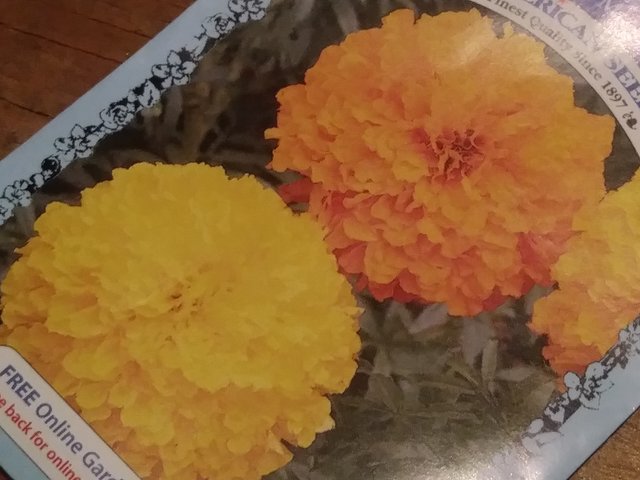Marigold - Ceremonial, Ornamental and Medicinal
Tagetes erecta
Commonly known as marigold, Tagetes erecta is known by many names. Mexican Marigold, Aztec marigold, and African marigold to name a few.
Marigolds, once called Mary’s Gold and was named, it’s said, after Jesus’ mother, the Virgin Mary.
Calendula is sometimes refered to as marigold, and is indeed a relative. The flower we’re talking about here is not calendula. Tagetes erecta is the full, ruffley, yellow to orange flower that many of us have planted around our vegetable gardens, standing guard against insects and fungus.
Aztec Ritual and Medicine
Native to Mexico, marigolds were used by the Aztecs for both ceremonial and medicinal purposes. Marigolds were given to sacrificial victims as an anesthetic and to induce hallucinations. They were also used to cover the bodies of the dead. It’s thought that the repellant quality of the flowers helped to keep insects off the bodies.
Bernal Diaz, a Conquistador sent to explore middle America, noted in his diary that in Montezuma’s palace garden, there was a space reserved for “the medicinal and useful herbs.” Later, scholar’s were sent to record the knowledge of the Aztecs. Their writings tell us that marigolds were used by the Aztecs to treat “cold” diseases. Cold disease, thought to be caused by dampness or excess body fluids, included any phlemy or feverish condition. Swelling, blisters and digestive complaints were cold diseases also treated with marigold. Afflictions with “devine” causes like gout, stiffness, or bloody coughs were treated with the herb as well.
The Aztecs, as recorded in scholars’ documents used infusions of marigold. Another common way it was used was to rub it in their hands with water.
Hints and traces of the Aztec way of using marigold can be observed in the way it’s used today in Mexico. The herb is still commonly used as a medicinal there, and marigolds are symbolically used during the Day of the Dead.
Mari’s Migration
Into Africa
In the 1500’s, marigold seeds were taken from the Aztecs and were cultivated in Spain. From there they spread into France and Africa.
Back To The America’s
Although American Indians used marigolds in medicine and ceremony, it wasn’t until after the Revolutionary War that marigolds began to make appearances in the gardens of the colonists. But they didn’t really catch on until the early 1900’s, when sweet peas and asters, the most popular flowers of the time, began to be hit hard with disease. In 1915, David Burpee saw that it was time to introduce a new flower into the gardens of America and chose marigolds to feature in his catalog that year.
And Finally, To India
India seems to be draped with marigold garlin. It’s used in celebrations and festivals. Becuse it seems to be such an ingrained part of Indian culture, it’s hard to believe that the flower has only been in India for about 350 years.
Marigolds are commonly used culinarily in India as a saffron substitute and to bring vibrant color to dishes.
Medicinal Uses
Blood Coagulation
In 2015, a research report was published by scientists from several universities and research groups including the Industrial Biotechnology Division, School of Bio Sciences and Technology VIT, University of Vellore India.
To stop bleeding, make a poultice from marigold leaves and apply it directly to the wound.
Antibacterial, Antifungal and Antimicrobial
A research article published in the International Journal of Pharmacy and Life Sciences shows that a diffusion of the leaf and flower of marigold has a “...broad spectrum of anti-bacterial activity”
A study published in 2004 showed that marigold has good antifungal properties. Interestingly, when the experiments were done in the dark, they weren’t as effective as they were when performed in light.
The antimicrobial activity of the plant is documented by the Phytochemical, Pharmacological and Microbiological Laboratory, Department of Biosciences (UGC-CAS), Saurashtra University, Gujarat, India in a 2015 research paper. The researchers found that extract of marigold is ”...useful in fighting emerging drug-resistant microorganisms...” It’s noted, however that the effectiveness was determined by the solvent used in the extract.
At home, an infusion applied to a wound or area affected by fungus can help prevent or treat infection.
Other Medicinal Uses For Marigold
Many studies have been done on the safety and effectiveness of Tagetes erecta. Anti-inflammatory, antioxidant, anti-diabetic, and hematological properties have been found in marigold. It’s been shown to be an effective insecticide and makes beautiful dyes and a healthy addition to chicken feed.
More Than a Stinky, Itchy Flower
Marigold has a fascinating story in ceremonial, ornamental and medicinal history. She may not be the beauty queen of the garden, but she’s earned a prominant and permanent place in mine.
CAUTIONS
As with all herbal medicinals, there are warnings and cautions to be taken.
- DO NOT use marigold medicinally if you are, could be, or are trying to be pregnant.
- DO NOT use marigold medicinally if you are breast feeding.
- DO NOT use marigold medicinally for children.
- ALWAYS do your own research and NEVER take my word for the safety of any medicinal herb.
- A paper writen for the NC State Extension warns of marigold being a topical irritant. You can find it here.
- Marigold is poisonous to dogs.
If you found this article informative and interesting, check these out:
The Ultimate Survival Plant
Mugwort - Medicinal Herb
Ashwaghanda - Medicinal Herb of Ayurvedic Medicine
My Very Favorite Medicinal Herb and Some Thoughts About a Giveaway




Nice article! I love marigold :)
So many wonderful usesb and the color! Always so cheery and brightening.
^that's really weird! I wonder why?
I know, totally counter intuitive. I couldn’t find any science explaining it...
Good write up on this powerhouse flower..
Thanks!
We have dwarf French marigolds in the garden and I rather like their smell. I think they look pretty gorgeous too!
I got them when we started having problems with root knot nematode and just let them self seed and pop up wherever. Pull them out occasionally if I want to plant something else. Good to know some of their uses. I've occasionally put the petals in salads, but didn't really know how to use them medicinally
I've just started really looking into the medicinal benefits of it after seeing marigold essential oil at a natural foods store a while back.